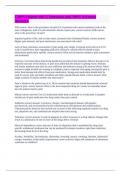CHPN chapter 4&5 || Questions and 100% Accurate
Answers.
With cancer, what is the prevalence of pain?1/3 of patients with cancer experience pain at the
time of diagnosis, well 2/3 with metastatic disease report pain. correct answers With cancer,
what is the prevalence of pain?
Impaired quality of life, and in some cases, increased risk of hastened Death. correct answers
Higher pain intensity and pain interference are associated with what?
Lack of basic education, assessment of pain using only simple screening tools such as 0 to 10
scale is insufficient, fears regarding addiction, tolerance, adverse effects related to pain
medications particularly opioids. correct answers What are the barriers related to pain assessment
and treatment?
Stoicism, concerned about distracting healthcare providers from treatment, believe the pain is an
expected outcome of the disease, or pain may admit that the disease is getting worse. Patients
and family members may also for your addiction and tolerance along with adverse effects. Other
reasons it might include not wanting to complain, pain is expected with aging, bearing the pain is
better than bearing side effects from pain medication, Strong pain medication should only be
used for severe pain and lastly morphine and other opioids Hasten death. correct answers Why
might a patient or family member not report pain?
Pain is whatever the patient says it is. Never assume that someone should demonstrate outward
signs of pain. correct answers What is the most important thing for a nurse to remember about
how the patient reports pain?
Misuse correct answers Use of a medication other than as directed or as indicated. Examples
include use of pain medication for sleep rather than pain control.
Addiction correct answers A primary, chronic, neurobiological disease with genetic,
psychosocial, and environmental factors influencing its development and manifestations.
Characterized by behavior that include one or more of the following impaired control over drug
use, impulsive use, and continued use despite harm and craving.
Tolerance correct answers A state of adaption in which exposure to a drug induces changes that
result in a diminution of one or more of the drugs affect overtime.
Physical dependence correct answers A state of adaptation that is manifested by drug class
specific withdrawal syndrome that can be produced by abrupt cessation, rapid dose reduction,
decreasing blood level of the drug.
Anxiety, irritability, lacrimination, rhinorrhea, sweating, nausea, vomiting, diarrhea, abdominal
cramps, insomnia, tachycardia, hypertension correct answers Signs and symptoms of abstinence
syndrome or withdrawl
, Opioid pseudoaddiction correct answers Patients develop certain behavioral characteristics of
psychological dependence as a consequence of in adequate pain treatment. These patients are
often described as difficult patient, chronic complainers, drug seekers. Patient will often resort to
Bizzarre a dramatic behavior in attempt to prove their pain is real so pain medications are
provided.
Double effect correct answers And ethical principle that permits in action, intended to have a
good effect, when there is a risk of also causing harmful affects, only when the intention was to
produce the good effect. And example of this would be giving high does opioids at end of life to
control pain, but may cause sedation.
Character correct answers explanation of pain using words such as tingling, burning, sharp,
shooting.
A change in the patient's behavior. correct answers The gold standard for measuring
effectiveness of pain interventions and patient's discomfort level.
Furrowed brow correct answers Number one indicator of pain for a patient who is unresponsive.
Peripheral neuropathy that occurs from both the virus and the treatment. Late stage HIV is often
associated with headaches from acute and chronic meningitis and chest pain from pneumonia
correct answers Most common pain syndrome seen in patients with HIV disease?
Chest pain caused by angina pectoris, respiratory syndrome's, third, panic attacks. correct
answers Most common pain seen with patients with cardiovascular disorders?
Somatic pain, visceral pain, referred pain correct answers Types of nociceptive pain include
Somatic pain correct answers Well localized, often described as deep, dull ache, musculoskeletal
in nature. Examples include bone metastasis, inflammation of soft tissue, and tumor invasion
Visceral pain correct answers Poorly localized; cramping, deep ache, pressure, often referred to
as distant; examples include bowel obstruction resulting in Bowel spasms, cholecystitis, primary
or metastatic tumors in the liver.
Pain from tumor involvement in the pancreas, lower esophagus, stomach, or retroperitoneal area
may be referred to the back. Gallbladder or liver disease may produce referred pain in the back
or right shoulder. Rectosigmoid involvement may result in pain and the sacrum a rectal area.
correct answers Examples of referred pain
Neuropathic pain correct answers Sharp, burning, shooting, shock like; examples include spinal
nerve root compression, tumor invasion of nerves, post herpetic neuralgia, or phantom limb pain




